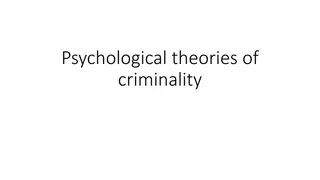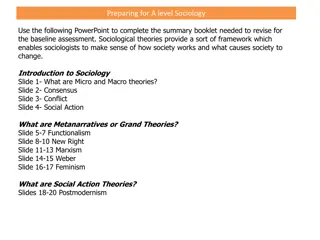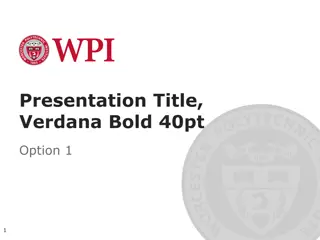Leadership Styles and Theories: An Overview
Explore the concept of leadership styles and theories, focusing on the different types of leadership styles such as autocratic, democratic, and laissez-faire. Learn about the components of a manager's leadership style, including motivation approaches, decision-making styles, and areas of emphasis in the work environment. Understand how each leadership style impacts the interaction between leaders and subordinates, influencing motivation and decision-making processes.
Download Presentation

Please find below an Image/Link to download the presentation.
The content on the website is provided AS IS for your information and personal use only. It may not be sold, licensed, or shared on other websites without obtaining consent from the author.If you encounter any issues during the download, it is possible that the publisher has removed the file from their server.
You are allowed to download the files provided on this website for personal or commercial use, subject to the condition that they are used lawfully. All files are the property of their respective owners.
The content on the website is provided AS IS for your information and personal use only. It may not be sold, licensed, or shared on other websites without obtaining consent from the author.
E N D
Presentation Transcript
Leadership and Change Management (MBA5023) Chapter TWO: Leadership Theories and Styles BY: Yissa Hassen (Ph.D Scholar) March, 2020 Debre Tabor, Ethiopia
What is Leadership style? What are the types of Leadership Style?
What is Leadership style? What are the types of Leadership Style?
Contd The focus on finding leadership style (behavior patterns of leaders) is on the relationship between leaders action and the reaction of subordinates emotionally and behaviorally. A manager s leadership style is composed of three parts:
Contd leadership style is composed of three parts: A. How the manager chooses to motivate subordinates Motivation approach Positive Responsibility Recognition Praise Security Monetary Rewards Negative Threats Coercion Fines Suspensions Termination
Contd B. His/her decision-making style: the degree of decision-making authority the manager grants to subordinates. C. His/her areas of emphasis (orientation) in the work environment: Task orientation, employee orientation.
Contd Based on the above points there are three types of leadership styles: A. Autocratic or Authoritative B. Democratic or Participative C. Laissez Fair or Free rein
A. Autocratic or authoritarian style It is closely associated with the classical approach to management. The manager who follows this style is dogmatic and leads by the ability to withhold or give rewards and punishment, i.e. motivation is through incentives and fear.
Contd. Under the autocratic leadership style, all decision-making powers are centralized in the leader, as with dictator leaders. They do not entertain any suggestions or initiatives from subordinates. The autocratic leadership has been successful as it provides strong motivation to the leader. It permits quick decision-making, as only one person decides for the whole group and keeps each decision to himself until he feels it is needed to be shared with the rest of the group. High degree of dependency on the leader May be valuable in some types of business where decisions need to be made quickly and decisively
Contd In this approach find the manager making the decision and then Selling it to employees or making the decision and allowing the group the opportunity to ask questions. The autocratic leader is task-oriented and places little value on showing subordinations as a leadership technique. The Autocratic manager assumption as his leadership. consideration to uses Theory base X philosophical for
Advantages When there is a need to influence subordinates in favor of organizational objectives which has an effect on individuals. When subordinates are new, they need to be directed. When the situation calls for unilateral decision-making perhaps there is no enough time for quality input from subordinates or the subordinates may lack information.
Disadvantages Employees /subordinates ideas will not be used to solve organizational problems, which in some cases subordinates may have better ideas than the superior about a particular problem. Subordinates would be demotivated, i.e. It may suppress individual initiative Poor implementation of decisions
Participative or democratic style The democratic leadership style favours decision- making by the group . They can win the cooperation of their group and can motivate them effectively and positively. The decisions are made with the consultation of group members and participation by them. Consultative: process of consultation before decisions are taken Persuasive: Leader takes decision and seeks to persuade others that the decision is correct.
Contd The leader delegates a great deal of authority while retaining ultimate responsibility. Active two-way communication (upward and downward) exists. The democrat leader uses Theory Y assumption as his/her philosophical base for leadership.
Contd The advantages of democratic leadership style are the disadvantages of the autocratic leadership style after we make them opposite. Disadvantages/Limitations Subordinates may be too involved to influence the manager even when there is no need. The manager may not be able to influence the subordinates to the extent needed. However, the major advantage of this leadership style is that, it enhances personal commitment through participation.
Laissez Faire or free rein style A free rein leader does not lead, but leaves the group entirely to itself such a leader allows maximum freedom to subordinates, i.e. they are given a free hand in deciding their own policies and methods. 1. Can be very useful in businesses where creative ideas are important 2. Can be highly motivational, as people have control over their working life 3. Can make coordination and decision making time-consuming and lacking in overall direction 4. Relies on good team work. 5. Relies on good interpersonal relations
Contd leaders generally give the group complete freedom, provide the necessary materials, participate only to answer questions, and avoid decision-making whenever possible. Leaders depend largely on subordinates to set their own goals and the means of achieving them, and they see their role as one of aiding the operations of followers by furnishing them information and acting primarily as a contact with the groups external environment, i.e. the leader s role is to serve as a logistics specialist or representative of the group to outside groups.
Contd The application of Laissez-Faire style can be found with individuals or groups that the manager views as being knowledgeable, independent, or motivated. Additionally, if the work group is composed of high achievers, or is highly research oriented, this style has potential benefits. Primarily horizontal communication among peers exists.
Contd Advantages It gives quite freedom for subordinates It gives much responsibility and self-guidance for subordinates It permits self-starters to do things as they see fit without leader Disadvantages Group may drift aimlessly in the absence of direction from leader. It may make things out of control.
Situational Leadership style The situational leadership style states that for a manager to be democrat, autocratic or laissez-faire, situations force him/her.























